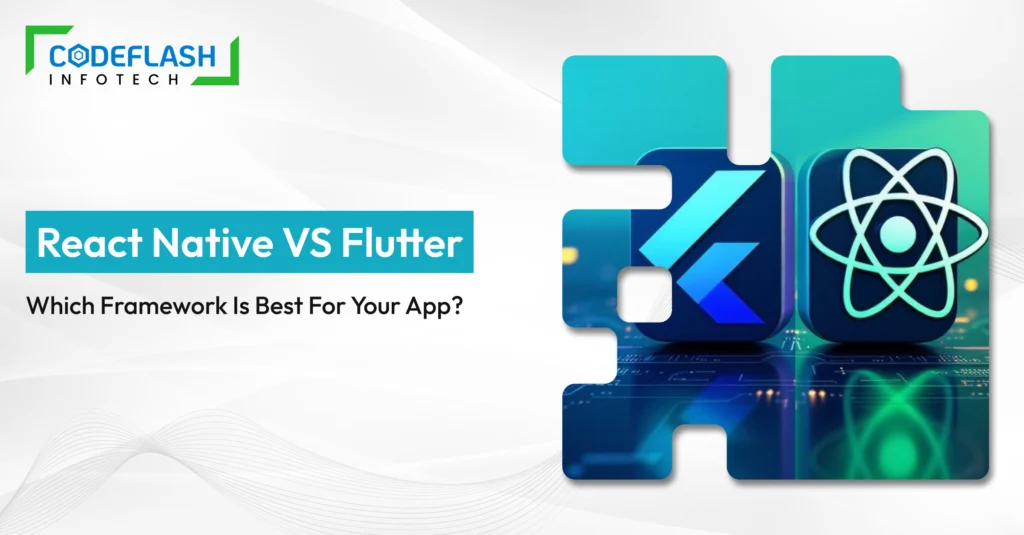
React Native vs Flutter: Which Framework Is Best for Your App?
03 JUNE
Choosing the correct framework matters greatly in today’s versatile mobile app development scene to ensure your digital product succeeds. As we step into 2025, the debate around React Native vs Flutter 2025 continues to gain momentum. They are well-known for allowing developers to build great apps with native-like looks, but each serves a separate group of needs and interests. According to the 2024 Stack Overflow Developer Survey, React Native is slightly more popular than Flutter among developers. When you pick the right technology, your startup can move forward rapidly, or your enterprise can grow easily with beautiful applications. In 2025, this article will compare React Native and Flutter so that you understand which one works best for your needs in building cross-platform apps.
Understanding the Basics
Facebook’s React Native helps developers write apps with JavaScript and shows these apps using native parts. Five years ago, it gained a strong reputation for allowing users to reuse components, having community backing, and being high-performing.
Flutter is also an open-source toolkit for building user interfaces, which Google debuted in 2017. It is developed with Dart and mainly aims to deliver top UI performance across platforms with only one base code.
Explore our success stories in cross-platform development. Check out our portfolio.
Performance and UI Experience in 2025
Over the next few years, both frameworks have significantly improved their results. The new architecture in React Native, including Fabric rendering and TurboModules, speeds up startup and adds smarter memory usage. Still, native bridges limit fast performance when the app needs to work quickly.
Thanks to Flutter’s constant 60 FPS, it still ranks top for user interface smoothness and rendering. As a result, the app doesn’t use a bridge, so it is both fast and efficient. Flutter is usually preferred when strong visual design and animated elements are essential in a project.
Developer Productivity and Learning Curve
Using JS, the primary language in web development, is a big reason why React Native is often the choice for many developers. Thanks to the many packages and the potential to use code on multiple platforms, development and prototyping can be done much faster. For teams offering React Native development services, this continues to be a strategic advantage.
This relatively new technology has invested considerable effort in making the development process more convenient for its users. ” Hot reload” and various widgets allow you to improve your app swiftly. Still, Dart is used less widely, which might mean new users have some catching up to do. Yet, those who value UI uniformity and want to avoid many platform-specific issues may find a Flutter app development company to be more efficient in the future.
Send us an email and get a personalized recommendation from our technical team.
Community and Ecosystem Growth
React Native stands out because it has a larger user community and provides access to many more plugins and third-party library integrations. Being maintained by Meta and supported by several open-source developers keeps OpenGraph current.
Flutter is gaining momentum quickly. Thanks to Google’s efforts to develop it for web, desktop, and embedded devices, new developers and businesses are interested in Flutter. The framework’s system grows with every update, giving it a stronger advantage over React Native.
Scalability and Use Cases
If you want to launch your product fast and access many developers, React Native is a good fit. Many startups and enterprises prefer to hire React Native developers to accelerate development while ensuring quality and performance. Apps like Instagram, Facebook, and Shopify show that it works as we expand.
Flutter performs best when focusing on rich UIs, lovely animations, and the same design on every device. Fintech, commerce, e-commerce, and healthcare apps are now using it more. Many companies hire Flutter developers because it is possible to make the same app for different devices and systems.
Which One Should You Choose in 2025?
There’s no one-size-fits-all answer when choosing between React Native and Flutter in 2025. Both are excellent frameworks for cross-platform app development, but your project’s specific needs should guide your decision.
When you want better development speed, a ready and mature toolkit, and shareable code for web and mobile, choose React Native. If you’re after an app that is visually striking and operates well on any platform, Flutter is the right choice.
The selection will depend on what your team knows, your business needs, and what sort of application you have. Both technologies will endure, and your choice will influence your app’s future results.
Conclusion
Both React Native and Flutter perform well in cross-platform app development in 2025. With a reliable and advanced environment plus fast development, React Native is right for companies asking for speed and flexibility. With Flutter, you can build UIs that offer the same high performance everywhere you use them. Make your decision based on how complex your app is, what its design should be, and what skills and support are available to develop it. Publishing your app with either Flutter or React Native depends on ensuring its development fits your vision.
Ready to build your next cross-platform app? Contact us today
Frequently Asked Questions
Many companies today prefer React Native because of its robust ecosystem, active community, and new changes that help it scale better and work faster.
Absolutely. Flutter development now supports running bigger projects and applications. Since it delivers improved performance, integrates well, and comes with valuable tools, it can support large enterprise projects in 2025.
Costs can vary based on developer experience and region. Because there are more React Native developers, users may find these services a little cheaper. However, both solutions are affordably priced for most engineering jobs.
How you migrate depends on how your app is currently built and the objectives you have set. Switching to Flutter can improve performance and the user interface. React Native is advantageous when your team already uses JavaScript.
Many startups choose React Native to develop their apps quickly and for less money. Yet, in cases where UI/UX is most important, Flutter allows for a better user experience with fewer changes for different platforms.





